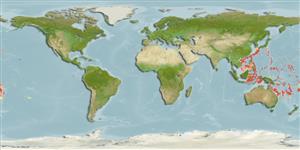>
Zeiformes (Dories) >
Grammicolepididae (Grammicolepidids) > Macrurocyttinae
Etymology: Macrurocyttus: Greek, makros = great + Greek, kyttaros, kytos = a convex cavity.
More on author: Fowler.
Environment: milieu / climate zone / depth range / distribution range
Ökologie
seewasser bathydemersal; tiefenbereich ? - 878 m (Ref. 40966). Deep-water
Western Central Pacific: Philippines (Ref. 40966) and Australia (Ref. 75154).
Size / Gewicht / Alter
Maturity: Lm ? range ? - ? cm
Found on the continental slope (Ref. 75154). Minimum depth from Ref. 58018.
Life cycle and mating behavior
Maturities | Fortpflanzung | Spawnings | Egg(s) | Fecundities | Larven
Heemstra, P.C., 1999. Macrurocyttidae. Dwarf dories. p. 2258. In K.E. Carpenter and V.H. Niem (eds.) FAO species identification guide for fishery purposes. The living marine resources of the Western Central Pacific. Volume 4. Bony fishes part 2 (Mugilidae to Carangidae). FAO, Rome. (Ref. 40499)
IUCN Rote Liste Status (Ref. 130435)
Bedrohung für Menschen
Harmless
Nutzung durch Menschen
Fischereien: nicht kommerziell
Tools
Zusatzinformationen
Download XML
Internet Quellen
Estimates based on models
Preferred temperature (Ref.
123201): 8.1 - 17.2, mean 12.9 °C (based on 84 cells).
Phylogenetic diversity index (Ref.
82804): PD
50 = 1.1250 [Uniqueness, from 0.5 = low to 2.0 = high].
Bayesian length-weight: a=0.01995 (0.00906 - 0.04395), b=3.01 (2.83 - 3.19), in cm total length, based on all LWR estimates for this body shape (Ref.
93245).
Trophic level (Ref.
69278): 3.8 ±0.8 se; based on size and trophs of closest relatives
Fishing Vulnerability (Ref.
59153): Low to moderate vulnerability (31 of 100).
